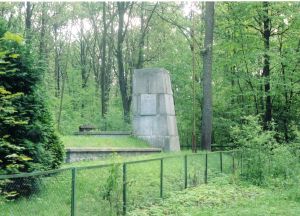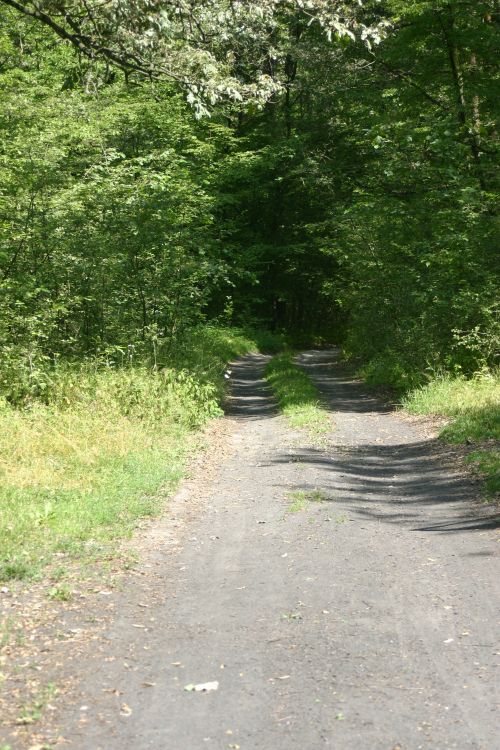Krepiecki Forest

Krepiecki Forest Monument 2004
The Krepiecki forest is approximately 12 kilometres on the way to Zamosc, from Lublin, and during the Second World War, the Nazis carried out mass executions at this site. On the 3 May 1940 the first execution took place in the forest, a group of Polish and Jewish was executed as a reprisal for the murder of a functionary of the Lublin SD, a certain SS-
The last 8,000 Jews were confined in the closed ghetto of Majdan Tatarski, in their midst was a large group who were “illegal” residing in the ghetto without documents. Only those Jews who possessed a J-
Many of the prisoners believed what the SS –men told them, until they stood on the path leading to the forest and started to hear the shots and screams of the first batch of victims. Approximately 300 young men from the group imprisoned at Lublin concentration camp, were admitted into the camp, thus these young men were spared from this brutal massacre. In addition to the young men thus spared, at the very last minute a small group of women and children was given permission to leave Lublin concentration camp, the president of the Lublin Judenrat Dr Marek Alten negotiated with Hermann Worthoff, who agreed to release several women with their children. The women were chiefly those whose husbands were either employed by the Lublin Judenrat or who worked for the German administration. Among this number was Anna Bach, the widow of Aron Bach, who was a famous advocate from Lublin, who died in 1940. She and her daughter Diana returned to the ghetto in Majdan Tatarski, and having witnessed the events in the Lublin concentration camp decided to escape from the ghetto, which they did, and both survived the Holocaust and the war. There were also several witnesses who saw the mass execution of Lublin’s Jews in April 1942, these were Poles who lived in the vicinity of the Krepiecki forest.
Shortly after the Germans were driven out of the region, a Polish –Soviet Commission for the Investigation of German Crimes at Lublin concentration camp, visited the forest and they took statements from the Polish inhabitants who described the mass executions. Andrzej Wojcik who lived on the edge of the Krepiecki forest observed the executions for a whole day in April 1942:
On the 22 April 1942 I was at home and suddenly I noticed that six or seven trucks, full of children between 2 and 14 years of age arrived at the forest. The children were driven down to the pits and the Germans shot them. From the place of the murder the cries and screams of the children could be heard. In all, this lasted from 2am until 6am. The Germans were in helmets and blue uniforms. It is difficult for me to say from which formation they were. Visibility was difficult because at the beginning it was still dark. I observed the massacre from a distance of about 50 m. I don’t know how many children were killed. They were transported by trucks, completely over-
About 8 a.m. nine trucks full of Jews arrived at the forest. The area was surrounded by Lithuanian soldiers. I know this because people described them to me as Lithuanians. The Jews were driven down from the trucks and they were led to the same place where the children were murdered. Some of the Jews held their children in their arms. I observed the massacre from a distance of about 150 m but from a different direction than before. Germans drove the Jews down to the pits. There were horrible screams. A group of six SS officers and Lithuanians shot into the Jews who were already in the pits. I’m sure that they were SS men because on their caps they had death’s head insignia and on their sleeves the signs of SS.
The execution lasted from 8 a.m. until 8 p.m. I observed these murders the entire time. I heard from people that a Jewess escaped from the mountain of bodies but that later, attempting to escape, she was shot in a field. The next day I went to the place of the executions and I noticed that the pits were covered partially by earth and partially by bushes. Legs, hands and heads stood out from the pits. The earth around the pits was covered in blood. I was there about 20 minutes.
Two or three days after the mass executions, Soviet Prisoners of War and several Slovakian Jews of the Sonderkommando from Lublin concentration camp – were taken to the forest to bury the bodies of the murdered Jews from Lublin. During the burying of the bodies in the forest, several members of the Sonderkommando revolted, a number of Soviet Prisoners of War attacked drunken Lithuanian guards and several prisoners escaped, but their eventual fate is unknown. The belongings, clothes, money and valuables were transferred to theLublin concentration camp, and the fate of the victims was soon known in the ghetto, as Polish eyewitnesses spoke about the mass executions.
Path into Krepiecki forest - 2004
The next wave of executions in the Krepiecki forest took place in the late summer and autumn of 1942. A typhus epidemic broke out at that time in Lublin concentration camp. The SS doctors in the camp organised a general selection of prisoners who were sick or unable to work. The selections took place at the end of August and throughout September 1942 and the selected prisoners, approximately several hundreds, were loaded onto trucks and transported to Krepiecki forest, where they were executed by SS-
The executions in Krepiecki forest ceased in October 1942 following the construction of the gas chambers at Lublin concentration camp, but because the crematoria could not cope, the Germans used the forest as a place where murdered Jews were burned. Primitive pyres were constructed from railroad tracks and virtually every day from January 1943 until the summer of that year early each morning trucks containing corpses arrived in the forest. A horrible stench permeated the whole area adjacent to the forest and the fire and smoke was visible from a great distance, the Nazis ordered the Sonderkommando from Lublin concentration camp to exhume the bodies of those murdered in 1942 and burn them on pyres.
One of the eyewitnesses of the mass cremations was Jozefa Lutynska who lived at Krepiecki:
I remember also how I travelled to Lublin in 1942 and 1943 and I saw maybe 12 trucks carrying human bodies covered by sheets. There was snow and wind that tore the sheets off and we saw the naked bodies, one on top of the other. There was much blood, fresh, red blood which was proof that these people had to have been alive not long before.
The bodies transported to the forest in Krepiecki were burned by the Germans on pyres specially prepared from railways. My uncle who was a forester, Adam Nowak lived in Krepiecki and guarded the forest in which Germans burned the bodies.
He told me one time, “Come, so you will see what the Germans have done there and they burn the bodies. I went once with my uncle and I saw rail tracks at a distance about 0.5m from each other. The railways comprised something like a grate.
Under each grate the traces of burning were visible with a lot of ashes and fragments of hands and legs that had not been totally burnt. I did not look at it in great detail because I was frightened of this place and I did not want to see it any more.
The burning of the bodies of those murdered in Lublin concentration camp lasted until the autumn of 1943 in the Krepiecki forest, until a new bigger crematorium was constructed in the camp.The execution and cremation sites in the forest were not totally destroyed and were visible even in 1946 when the Polish – Soviet commission visited the site.
In 1970 a memorial was built in the Krepiecki forest, the memorial bears the statement that there were about 30,000 people killed or burned there, but in fact it is impossible to determine with any certainty whether this figure is correct.
Sources:
Institute of National Remembrance in Lublin – Collection of the Regional Commission for the Investigation of Nazi Crimes in Lublin
Investigation about the Crimes in Krepiecki Forest 1966-
Archive of the Majdanek State Museum in Lublin: Documents of the Polish – Soviet Commission for the Investigation of German Crimes at Majdanek 1944, collection of testimonies and memoirs by survivors.
Piec lat na muszce. Wspomnienia wieznia Majdanka by W. Dobrowolski Lublin 1994
Zbrodnie w lesie Krepieckim w swietle zeznan swiadkow by Robert Kuwalek – Zeszyty Majdanka” Vol XXI (2001)
Listy z Majdanka – Z. Wojcikowska, Lublin 1962
Majdanek Archive
Photographs – Chris Webb Archive
© Holocaust Historical Society 2018


